

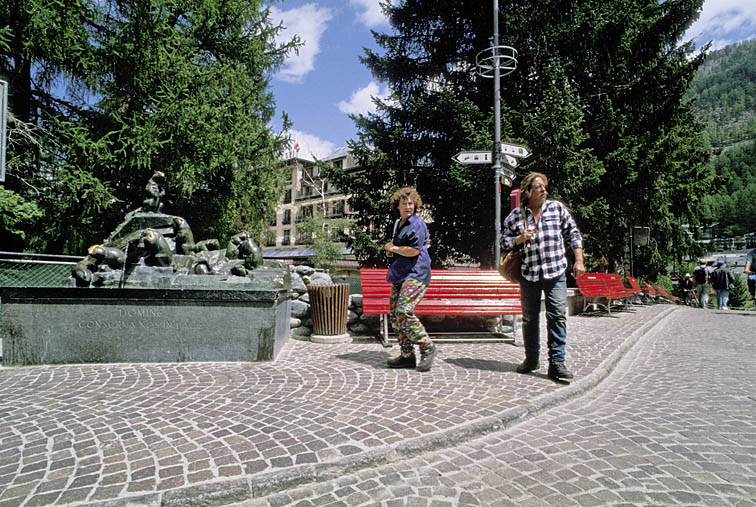
Excellent amenities for pedestrians, Zermatt, Switzerland


1998 J.Crawford
In the last article, we considered the public transport improvements that are necessary to support large-scale carfree conversions. Those changes will be time-consuming and costly. Here we turn to the need for better cycling and walking. It is not enough simply to remove cars and trucks from the street.
Fortunately, the necessary changes are fast, cheap, and delightful. They will yield large improvements in the quality of street space, which in turn should bring sharply improved function as social space. The streets will look and feel completely different once this is completed, even though the actual changes are not so large.
Improvement in the quality of the streets as social spaces is vital. The common complaint in modern industrialized societies is social isolation. It is no coincidence that this problem arose in parallel with the arrival of widespread car usage. It is not just that people in cars are highly isolated from their fellow citizens, it is that the cars themselves damage the social functioning of public spaces.
Once cars are gone, the streets will become quieter, safer, and far more attractive places. Even without much effort, their function as social spaces will improve dramatically. If evidence of this is required, we need only consult the work of Donald Appleyard, in particular his seminal Livable Streets.
As you can see in Times Square, above, simply removing the cars helps a lot, but it is not enough. The hasty conversion of several blocks of Broadway reveals the need for planning and action to reap the full benefits. In the case of Times Square, only minimal improvements were made to the space. Even so, pedestrians hungry for space immediately took over the raw street and the hundreds of lawn chairs the city supplied. (In fairness to New York, the change was made on a trial basis. Improvements are in progress.)
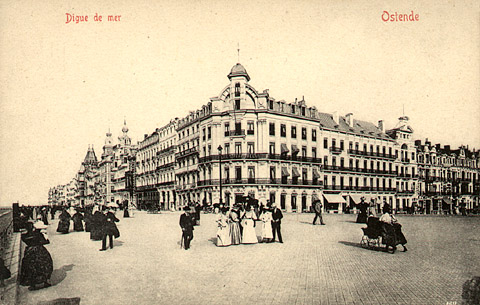
A street for people, before cars, Ostende, Belgium


c. 1900 anon
Look at street scenes from a century ago. Notice how strongly integrated the streets are in the pre-automobile age. There is no reason that we cannot return to the simplicity and beauty of that era. Prove to yourself the importance of this change. Visit a randomly-chosen city street corner. Mentally remove from the scene everything that is needed because the street is used by cars. Speeding cars, parked cars, parking meters, pavement marking, traffic signals, gasoline (petrol) stations, traffic signs, overly-large commercial signs, and so forth clutter your field of view on most city streets. You will discover that the appearance of the street would change quite dramatically, and entirely for the better, if this clutter were removed.
We need to put outdoor furniture in these spaces once the cars are gone. This should be better than flimsy aluminum-and-plastic lawn chairs. Something more along the lines of the example from Zermatt is needed. And be sure to consult the work of William H. Whyte on making public spaces that the public will use and cherish. This is not difficult, but some thought is required. Whyte firmly believed that seating should be adjustable by the sitter. He gives countless examples of people coming up to a chair and making a change in its location and orientation. Some of the changes are so small that one wonders why any change was made at all. But notice your own behavior around chairs. Observe that you do, in fact, tend to adjust their position, sometimes minutely.
Besides seating, there are many other elements that fall under the category of "furniture."
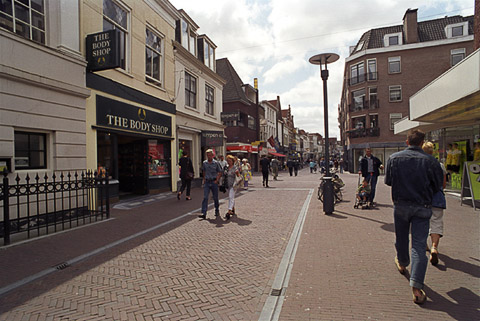
Amersfoort, storm drains: a small-scale solution for a narrow street


2002 J.Crawford
Curbs are probably no longer necessary, which means that curb-cuts, an ever-present tripping hazard, can also be removed. Some means is required to channel storm water to drains, but this can be quite simple and unobtrusive, as shown above. Accessibility problems are greatly reduced when curbs are eliminated. This helps not only people in wheelchairs but anyone using wheeled carts, baby buggies, or bikes.
We are free to add many things to the streets, because, in nearly all cases, the street space that becomes available will be much larger than pedestrians and bicyclists require. The amenities that we add should be chosen specifically to improve life on the street.

Fountain, Lisbon


1998 J.Crawford
People love water. Kids really love water. There's plenty of room for it once the cars are gone. The roar of cars will be replaced by the quiet splash of water, and sometimes by the shrieks of delighted children. It's difficult to make a bad fountain. Practically anything you can do with water will improve the street. Just don't drown the kids.

Street plantings in Basel, Switzerland


2002 J.Crawford
The streets of most modern cities are barren. Cars have taken up most of the space that could have been used for plants and trees. Although trees can bring their own problems, think about planting some. Yes, the roots can get into the sewers and break up the pavement, but these problems can be managed. When trees are thought too difficult, portable planters can still bring green onto the street, as shown in Basel, above.
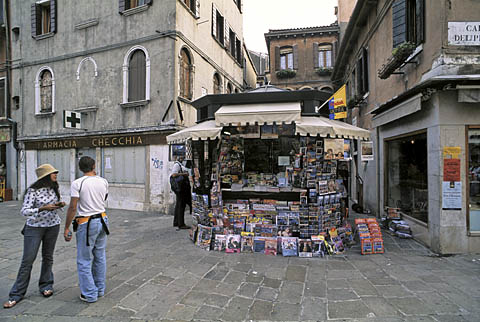
News Kiosk, Venice


2002 J.Crawford
News kiosks are found all over Europe and are quite common in many North American cities as well. European kiosks carry an astounding variety of useful things beyond newspapers and magazines. Transit passes, maps, lighters, candy, and so on. If it's small and doesn't require refrigeration, it can probably be sold in a kiosk. A good kiosk can become a social center in its own right and takes up very little space. Be liberal in their use.
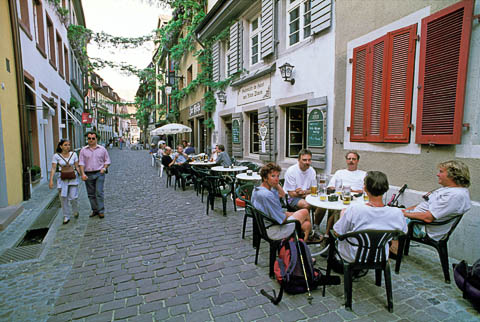
A small outdoor café that fits in a narrow street, Freiburg, Germany


1998 J.Crawford
Perhaps nothing characterizes the quality of life in Europe better than the outdoor café. They are found from one end of the continent to the other, even in surprisingly cold climates. They are a major hub of social activity. Governments in some countries provide small incentives to their owners, in recognition of their social importance. Although they continue to exist in streets with car traffic, their function is significantly impaired by the noise, stink, and ugliness of car traffic. Put a café on every street corner in busy parts of town.

Local market, Venice


2002 J.Crawford
You will not want a great many markets, but any thriving district can support one. Once again, Europe shows the way. Most cities there still have outdoor markets that are a central facility in their neighborhoods. Here again, some governments have recognized the importance of their function and provide preferential tax treatment to stall holders. They are an excellent means of bringing life's daily necessities into every district. They should be centrally located. Often they can serve as an extension of the surrounding stores. Be wary of allowing truck traffic to serve markets. The practice is common, and in some cases it cannot (now) be avoided. However, as a long-term solution, trucks damage the very goose that lays the market eggs.
Better Biking
The cycling improvements are quite obvious and well known to every urban cyclist. Sewer drains need to be designed not to trap wheels. Pot holes need to be fixed correctly. Once the cars and especially trucks are gone, the streets should remain in good condition for much longer periods. Good bike racks are needed. In particularly dense parts of the city, multi-story bike parking garages may be needed. Amsterdam has a huge one, right next to the central train station.
I have long advocated what I call the drag-and-drop bike. The city puts out thousands of them. You grab one, ride it to your destination, throw it in a rack, and forget it. No coins, no passes, no locks, nothing. The seat height needs to be easily adjustable. Beyond that, the cheapest possible bikes can be used. Thefts can simply be tolerated, and they will be a comparatively minor problem if the bikes are indelibly marked with the name of the city that owns them. Paris has recently had some problems with its Velib system. Those bikes, which are not free and are somewhat of a nuisance to use, apparently cost well over a thousand Euros each. (I can't understand how.) Cheap, mass-produced 12-speed bikes can be had at retail for under $50 in some markets. A city buying thousands of single-speed bikes should be able to get a better deal than that.
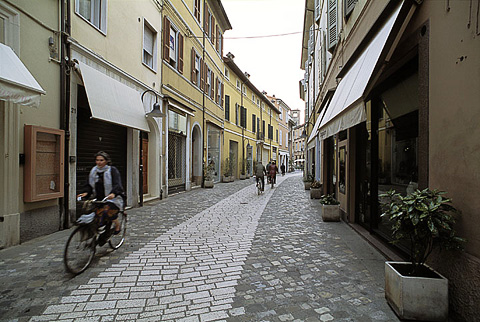
Simple traffic division scheme, Ravenna


2002 J.Crawford
Resist the temptation to install strong divisions between bikes and pedestrians. Something like the scheme used in Ravenna, above, is adequate. The bikes are supposed to use the white area in the middle. Pedestrians are supposed to use the darker part of the pavement. Nobody freaks out if someone is in the "wrong" place. People who, for whatever reason, are not where they are supposed to be should be alert to other street users, to make sure they aren't blocking them. And in streets this narrow, a reasonably sedate speed should be enough for cyclists. Larger streets with heavy bike traffic probably do want separate lanes and may even need traffic signals. But, for the smaller streets, cheap and simple is enough.

Never forget the alternative to lively, carfree streets, Lisbon


2003 J.Crawford
In your efforts to convert neighborhoods in your city to the carfree model, be patient. It will be difficult, frustrating, and time-consuming. When you waver, just keep the photograph above in mind. Think what a wonderful street this could be, if not for the cars. That should give you incentive enough to carry on. And good luck.
In the next issue we will consider how to start conversions (at the transport halts) and how to increase urban density (add buildings that make the streets narrower).
First published in CarBusters #37 (February-April 2009).
|